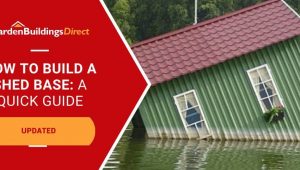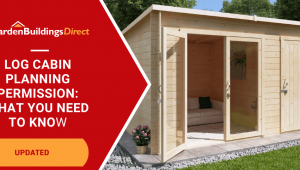Jump to:
Wooden garden buildings, like summer houses, can be seen with condensation on the windows inside and sometimes on their interior walls, especially during a humid British summer. Even with care, moisture can still creep in from issues that aren’t always easy to spot.
Condensation inside a wooden summer house, if left alone, could lead to mould and structural problems. This guide will walk you through what causes it and how you can stop it from messing up your time in your outdoor retreat.
What Leads to Condensation in a Summer House?
To stop condensation, you have to know the driving factors in your summer house first.
Temperature fluctuation
Temperature fluctuation is one of the main causes of excessive moisture build-up. When it drops, the air can no longer hold as much moisture, which is referred to as humidity. This results in water vapour condensing out of the air.
Water droplets on windows are among the common signs. This is likely when there’s high humidity in the summer house and a big temperature difference between the inside and outside.
Humidity level from people using the space
Occupants release moisture into the air through breathing and sweating. If you use the building as a garden gym, working out can add to this. For one, physical activity increases the amount of moisture your body releases, making the space more humid.
Plants can also contribute to humidity by releasing water vapour through transpiration. However, plants don’t typically contribute nearly as much compared to human occupants.
Lack of ventilation
In relation to the humidity above, not enough fresh air coming into the summer house can increase the level. Not only can this lead to condensation, but it can also make the air feel hot, stuffy, and damp inside. Using the same example of a ‘garden gym,’ imagine what would happen if ventilation is limited, paired with a high humidity level?
But even with low humidity, poor airflow could still make things worse, regardless of how you use your summer house. Signs to look out for include damp patches or peeling paint on the walls, the floor starting to warp, swell, or feel damp, and water stains around the edges of the roof.
Untreated wooden summer house
Wood is a favoured material for garden buildings. It’s strong, easy to work with, and looks fabulous in gardens. However, it can be vulnerable when left untreated.
Outdoor elements and harsh weather conditions can take a toll, and this is just the start of many issues that may arise. This includes having no protection against moisture. So, when humidity builds up inside the summer house, the wood can absorb some of it. This worsens condensation because the damp air has nowhere to go and stays trapped.
How to Stop Condensation in Your Summer House?
Now that you know the main causes, it’s much easier to figure out what steps you can take to solve these issues. Plus, you’ll know what signs to look for around your summer house.
You can never go wrong with insulation
Insulating your summer house will help maintain a more stable temperature inside and therefore reduce the ability for moisture to cling to surfaces. Insulation works as a barrier that reduces heat transfer between the inside and outside of the structure.
Rigid foams are known for their excellent thermal resistance, making them a great choice for floors and walls. The same goes for mineral wool, as well as PIR insulation boards for the roof.
You can do this yourself or hire a professional for proper installation. Experts can also recommend the best type of insulation for your summer house.
Note: If you have a log cabin summer house, insulation is still worth considering. While the thick logs offer some insulating qualities already, adding extra insulation can provide more comfort and reduce condensation.
Use a dehumidifier and choose your plants wisely
A dehumidifier is great for controlling the moisture levels in the air. Whatever you plan to use the space for, make sure to leave some room for it in the corner.
You could also limit the number of plants or replace them with moisture-absorbing varieties. Plants that can absorb moisture include Peace Lily, English Ivy, Spider Plant, Boston Fern, Areca Palm, and Bamboo Palm. However, their dehumidifying effect may not be significant in larger spaces or with especially high levels of humidity.
Improve airflow inside your summer house
You can do this by installing vents or an exhaust fan so air can move around and keep the space cooler and drier. Even small changes like cracking open a window (if they open) or leaving the doors open periodically can help.
If you’re using the summer house for exercise or other activities that generate moisture, our guide to ‘How to Ventilate Your Garden Gym’ has more tips for you!
Treat your summer house
The right wood treatment can help keep the wood dry and reduce the risk of moisture build-up that could lead to condensation. It also prevents the wood from rotting, warping, or weakening over time.
Opt for deeply penetrating, water-repellent options like tung oil, linseed oil, or silicone cream emulsions. Emulsion creams, for instance, retain the wood’s natural appearance while ensuring it stays protected against moisture and the elements. Treat the building annually, or at least every couple of years, to maintain its condition.
Now, if it’s a pressure-treated summer house, it will likely require less frequent treatment. Yet, keep in mind that pressure-treated wood mainly helps with durability and resisting insects. You can still treat it with a water-repellent solution or use insulation to manage humidity.
As a rule of thumb, wait for the pressure-treated structure to dry out after installation for 3-4 months or longer, up to 6 months, before applying treatment. If yours hasn’t been treated in years, you can go ahead with treatment as long as the surface is clean and free of debris.
Round-up
Insulation solves the problem of temperature fluctuations that lead to condensation. A dehumidifier also helps reduce humidity levels, while ventilation is needed to address the lack of airflow inside. Lastly, treating the wood goes a long way, even if the summer house is pressure-treated, but the rules still apply.
You’ve got this now!
See our summer house guide for everything you need to know about these fabulous garden buildings.





